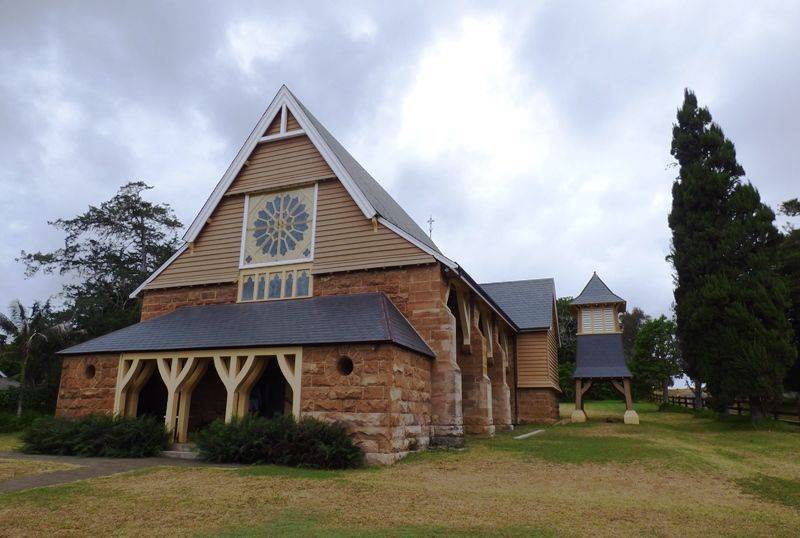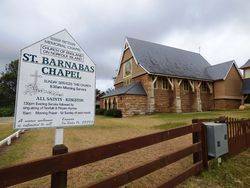
Bishop John Coleridge PattesonPrint Page 
St. Barnabas Chapel was erected to commemorate John Coleridge Patteson, Bishop of Melanesia, who was killed at Nukapu in 1871. The foundation stone was laid on the November 1875 but the building was not completed until June 1880. The church was consecrated on the 7th December 1880.
In March 1855, Patteson sailed in the Duke of Portland and arrived at Auckland in July. For five years he sailed in the schooner Southern Cross on annual cruises among the islands and ran the mission's summer school at Kohimarama, Auckland. On 24 February 1861 at Auckland he was consecrated first bishop of Melanesia. A brilliant linguist, he later spoke twenty-three of the many Melanesian languages: finding them in groups, he printed grammars and vocabularies and translated some gospels into the Mota dialect. Each year he spent some months on Mota in the New Hebrides.
In March 1864 Patteson visited Australia. In Sydney he addressed a large meeting which pledged systematic support of the Melanesian Mission; the Anglican Churches agreed to meet the annual expenses of the Southern Cross. In 1865 the governor of New South Wales, Sir John Young offered him a grant on Norfolk Island for his headquarters. In 1867 the Melanesian Mission moved to Norfolk Island where it was called St Barnabas.
The visits to the islands were becoming yearly more dangerous. In 1869 he noted the depopulation of many islands and that unscrupulous traders used his name to entice native inhabitants aboard their ships. In July 1870 he told Bowen that 'it is the regulation rather than the suppression of the employment of native labourers that I advocate'. In an official memorandum he advocated the licensing of a few ships to transport the islanders; all others were to be treated as pirates and confiscated summarily when caught, and frigates were to cruise constantly among the islands. In January 1871 he made another appeal for imperial legislation on Pacific Island labour.
In April Patteson sailed to the islands in the Southern Cross. On 20 September he landed alone on Nukapu near Santa Cruz where he was clubbed to death in retribution for a recent outrage by slave traders. In a canoe his body was taken to the Southern Cross and was buried at sea. Despite the plea of missionaries at Norfolk Island for no retribution Captain Markham of H.M.S. Rosario fired at and killed some natives.
The Melanesian Mission continued to expand on Patteson's foundations while his life was a lasting inspiration to the Anglican Church in Australasia. Patteson's death led to the imperial Kidnapping Acts of 1872 and 1875 along the lines he had suggested.
The mission schooner Southern Cross arrived on the 19th, bringing Mr. Selwyn and his boys all well, and preparations were at once commenced for laying the foundation stone of the Bishop Patteson Memorial Chapel before the vessel's departure for Auckland. On Monday, 22nd, the day appointed, a large gathering assembled at St Barnabas to witness the ceremony, most of the Norfolk Islanders being present. The place was gaily decorated. At 11 o'clock, the Revs. Messrs. Codrington, Nobbs, Byce, Selwyn, Still, and Penny arrived on the ground, and the ceremony commenced by the mission boys singing a hymn. Mr. Codrington then delivered a short but impressive address in English and Mota, and then proceeded to lay the stone ; the ceremony was concluded with a hymn sung by the Norfolk Islanders, and after a distribution of cake and wine, the assembly dispersed.
Sydney Mail and New South Wales Advertiser (NSW ),
18 December 1875.
Location
| Address: | Douglas Drive , St Barnabas Chapel, Norfolk Island, 2899 |
|---|---|
| State: | NSW |
| Area: | AUS |
| GPS Coordinates: | Lat: -29.033808 Long: 167.928279 Note: GPS Coordinates are approximate. |
Details
| Monument Type: | Structure |
|---|---|
| Monument Theme: | People |
| Sub-Theme: | Religion |
Dedication
| Actual Monument Dedication Date: | Wednesday 22nd December, 1875 |
|---|





 Chapel Consecration 1880
Chapel Consecration 1880
